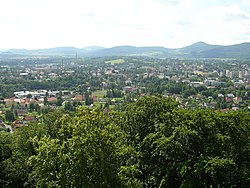Varnsdorf | |
|---|---|
 General view of Varnsdorf | |
| Coordinates: 50°54′42″N 14°37′6″E / 50.91167°N 14.61833°E | |
| Country | |
| Region | Ústí nad Labem |
| District | Děčín |
| First mentioned | 1357 |
| Government | |
| • Mayor | Jan Šimek |
| Area | |
• Total | 26.23 km2 (10.13 sq mi) |
| Elevation | 332 m (1,089 ft) |
| Population (2024-01-01)[1] | |
• Total | 14,716 |
| • Density | 560/km2 (1,500/sq mi) |
| Time zone | UTC+1 (CET) |
| • Summer (DST) | UTC+2 (CEST) |
| Postal code | 407 47 |
| Website | www |
Varnsdorf (Czech pronunciation: [ˈvarnzdorf]; German: Warnsdorf) is a town in the Ústí nad Labem Region of the Czech Republic. It has about 15,000 inhabitants. It lies on the border with Germany.
Administrative parts
The villages of Studánka and Světliny 1.díl are administrative parts of Varnsdorf.
Geography
Varnsdorf is located about 31 kilometres (19 mi) northeast of Děčín. It lies in the salient region of Šluknov Hook, on the border with Germany.
Varnsdorf is situated in the Lusatian Highlands. The highest point is the hill Špičák at 544 m (1,785 ft) above sea level. The Mandau river flows through the town.
History
The first written mention of Varnsdorf is from 1357. In 1681 Varnsdorf with the whole manor was purchased by the House of Liechtenstein and it remained in their possession until 1919.[2]
In 1849, Old Varnsdorf merged with five municipalities and created a new municipality called Varnsdorf. It was the largest municipality in Austrian Empire by population without town rights. In 1868, Varnsdorf became a town.[2]
Prior to the end of World War I, Varnsdorf was part of Austria-Hungary. According to the Treaty of Saint-Germain-en-Laye, the town became part of the newly established Czechoslovakia in 1918.[3]
Before the Holocaust, 211 Jews lived in Varnsdorf.[4] Following the end of World War II, its ethnic German population was mostly expelled to Germany.
In 1980, the municipality of Studánka joined Varnsdorf.[2]
Demographics
|
|
| ||||||||||||||||||||||||||||||||||||||||||||||||||||||
| Source: Censuses[5][6] | ||||||||||||||||||||||||||||||||||||||||||||||||||||||||
Around 2,500 Buddhist Vietnamese live in and around Varnsdorf. In 2008, the Thien An Buddhist Pagoda was consecrated in Varnsdorf, the first Vietnamese Buddhist temple in the Czech Republic.[7]
Economy

Varnsdorf is an industrial centre of the region. The town became well known for the textile industry. Its tradition here dates back to 1777, when the Velveta company was founded and became a significant manufacturer of cotton fabrics, especially for clothing purposes.[8][9] Other big textile company with headquarters in Varnsdorf is Frottana, producer of towels.
The engineering industry is represented by Továrny obráběcích strojů – TOS company (machine tools manufacturer) and KWL s.r.o., producer of cable harnesses.[8]
Varnsdorf is also home to the Kocour Brewery, who make a range of ales, including American style IPA and a stout.
Transport
Varnsdorf has road border crossings to the Saxon towns of Seifhennersdorf and Großschönau, and a railway border crossing to Großschönau.
Varnsdorf is located on the regional railway line Liberec–Seifhennersdorf and on the local railway line Varnsdorf–Rybniště. The town is served by three train stations: Varnsdorf, Varnsdorf staré nádraží and Varnsdorf-pivovar Kocour.[10]
Culture

Varnsdorf is home to the Town Theatre Varnsdorf. The theatre building includes a gallery.
Sport
The town's football club FK Varnsdorf plays in the Czech National Football League.
Sights

The Church of Saints Peter and Paul is the oldest church in the town. It was built in 1774–1776 on the site of the original church from the 13th century. Its late baroque decoration was finished in 1777.[11]
In 1872, the Church of Saint Francis of Assisi in the Romanesque Revival style was built in Studánka. The Old Catholic Church was built in 1875. The neo-Gothic Evangelical church (so-called "Red Church") was built in 1905. The Church of Saint Charles Borromeo was finished in 1912.[11]
Other sights include various Art Nouveau and Neo-Renaissance buildings in the town and Varnsdorf Museum.
Notable people
- Joseph Schubert (1754–1837), German composer, violinist and violist
- Heinrich Brandler (1881–1967), leader of the Communist Party of Germany
- Gernot Zippe (1917–2008), engineer and inventor of Zippe-type centrifuge
- Peter Kien (1919–1944), poet
- Evelyn Opela (born 1945), German actress
- Josef Berger (born 1949), biologist
- Iva Ritschelová (1964–2017), economist and academic
References
- ^ "Population of Municipalities – 1 January 2024". Czech Statistical Office. 2024-05-17.
- ^ a b c "Historie v datech" (in Czech). Město Varnsdorf. Retrieved 2021-07-14.
- ^ Mommsen, Hans; Kováč, Dušan; Malíř, Jiří (2001). "Im Widerstreit der Selbstbestimmungsansprüche: vom Habsburgerstaat zur Tschechoslowakei–die Deutschen der böhmischen Länder 1918 bis 1919". Der Erste Weltkrieg und die Beziehungen zwischen Tschechen, Slowaken und Deutschen (in German). Klartext. p. 201. ISBN 3-88474-951-X.
- ^ "Varnsdorf: Decin, Bohemia". International Association of Jewish Genealogical Societies. Retrieved 2022-08-10.
- ^ "Historický lexikon obcí České republiky 1869–2011" (in Czech). Czech Statistical Office. 2015-12-21.
- ^ "Population Census 2021: Population by sex". Public Database. Czech Statistical Office. 2021-03-27.
- ^ "Czech Republic first Buddhist temple opens". Buddhist Channel. 2008-02-06.
- ^ a b "Hospodářství" (in Czech). Město Varnsdorf. Retrieved 2021-07-14.
- ^ "Historie" (in Czech). VELVETA a.s. Retrieved 2021-07-14.
- ^ "Detail stanice Varnsdorf" (in Czech). České dráhy. Retrieved 2024-05-19.
- ^ a b "Památky" (in Czech). Město Varnsdorf. Retrieved 2021-07-14.
External links
- Official website
- Official website (in English)
- Town's information centre











